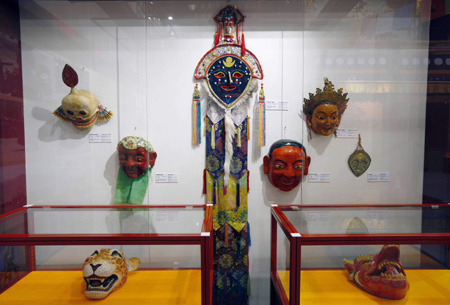|
![Raidi, former vice-chairman of the Standing Committee of the National People's Congress delivers a speech at the opening ceremony of the Tibet Intangible Cultural Heritages Exhibition in Macao on Friday, March 20, 2009. [Photo: CRIENGLISH.com] Raidi, former vice-chairman of the Standing Committee of the National People's Congress delivers a speech at the opening ceremony of the Tibet Intangible Cultural Heritages Exhibition in Macao on Friday, March 20, 2009. [Photo: CRIENGLISH.com]](http://images.china.cn/attachement/jpg/site1007/20090321/0019b93bd68d0b2e91b501.jpg)
|
|
Raidi, former vice-chairman of the Standing Committee of the National People's Congress delivers a speech at the opening ceremony of the Tibet Intangible Cultural Heritages Exhibition in Macao on Friday, March 20, 2009. [Photo: CRIENGLISH.com] |
An exhibition on Tibet intangible cultural legacies opened in Macao on Friday to show visitors the full scope of the autonomous region's unique cultural heritage.
With the theme of "Customs and Practices in Snow-capped Plateau", the five-day exhibition features three parts: Home Upon Plateau, Eternal Land of Purity and Folk Literature Operas, Music and Dance.
Raidi, former vice-chairman of the standing committee of the National People's Congress, says as an inalienable part of China and an important member of the Chinese family, Tibet has a unique and attractive culture with a long history and diverse performing forms.
"Relying on mutual exchanges with other nationalities' cultures in China and integration with external civilizations, Tibet has formed its unique culture with a large number of material cultural heritages such as the Potala Palace, a landmark religious complex, as well as plentiful intangible cultural heritages."
The exhibition displays more than 120 photos, about 100 objects and documents and many audiovisual materials to present the eye-catching Tibetan culture and mark the 50th anniversary of Democratic Reform in Tibet.
Also available are simulated scenarios to show the development of the Tibetan culture and the great changes that have taken place in last five decades.
Zhao Shaohua, deputy minister of the Ministry of Culture, hails the exhibition, which is being held in Macao for the first time.
"It can not only help Macao people better know the tradition of the non-material cultural legacies in Tibet, but also promote cultural exchanges between the mainland and Macao."
After seeing the exhibition, Cai Hengxin, who works in a local casino, said it's a good approach to learning about Tibetan culture.
|

|
|
Tibetan opera masks are seen in the Exhibition of Essence of Tibetan Intangible Cultural Heritage in Macao, south China, on March 20, 2009. The five-day exhibition was opened here on Friday, displaying 99 exhibits that are of Tibetan cultural importance. [Xinhua] |
"It's very educational and impressive. The large number of original documents, which I have never seen before, presents a comprehensive view of the development of the Tibetan culture."
Since the 1990s, the conservation work on Tibetan Intangible Cultural Heritage has been carried out on a wider scale and on a deeper level.
At present, 60 Tibetan Intangible Cultural Heritage items have been catalogued on the National Intangible Cultural Heritage List. Thirty-one Tibetan folk artists have been chosen as representative transmitters and listed among the Transmitters of National Level Intangible Cultural Heritage directory.
(CRI March 21, 2009)